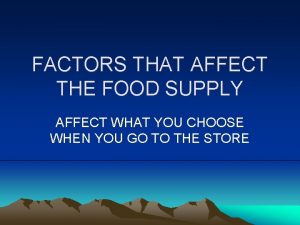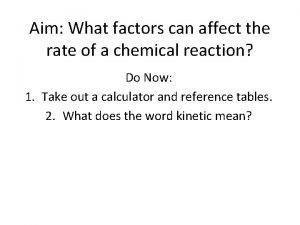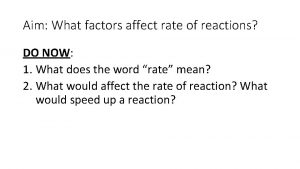Aim 45 What are the factors that affect










- Slides: 10

Aim # 45: What are the factors that affect solubility? H. W. # 45 Study pp. 514 – 521 (Sec. 11. 2 – 11. 3) p. A 33 (Appendix A 7. 5) Ans. ques. p. 548 # 93 p. 544 # 40, 43, 45, 47 p. 548 # 94 p. A (MC) # 1, 6 Do Now: Zumdahl 8 th ed. p. 531 #15 p. 536 # 98

I Energy changes associated with solution formation A. ΔHsoln = ΔH 1 + ΔH 2 + ΔH 3 where ΔHsoln = enthalpy of solution ΔH 1 = energy needed to separate solute molecules ΔH 2 = energy needed to separate solvent molecules ΔH 3 = energy change due to solvent-solute interactions ΔH 1 and ΔH 2 are usually positive ΔH 3 is usually negative

separated solvent particles E n t h a l p y + separated solute particles ΔH 2 solvent + separated solute particles ΔH 1 ΔH 3 solvent + solute ΔHsoln solution a net exothermic process ΔH 3 > ΔH 1 + ΔH 2 and ΔHsoln < 0

separated solvent particles + separated solute particles ΔH 2 solvent + separated solute particles ΔH 3 ΔH 1 solution ΔHsoln solvent + solute a net endothermic process ΔH 3 < ΔH 1 + ΔH 2 and ΔHsoln > 0

B. Factors affecting spontaneous solution formation 1. ΔH (change in enthalpy) A loss of energy favors spontaneous processes. 2. ΔS (change in entropy) Entropy is a measure of the randomness (or disorder) of a system. An increase in entropy favors spontaneous processes. If ΔS due to mixing is large enough, a solution will form spontaneously, even if ΔH is positive.

II Solute-solvent interactions A. London forces – solubility of gases in a liquid solvent tends to increase with MW. N 2 < CO < O 2 < Ar < Kr B. Chemical reaction between solute and solvent may result in increased solubility. e. g. CO 2 + H 2 O H 2 CO 3 (aq) however N 2 + H 2 O x no reaction C. Hydrogen bonding between solute and solvent molecules increases solubility H H |δ+ | δ- O H‒C‒C‒Oδδ+ H | | Hδ+ H H

Glucose has 5 –OH groups in its molecules, and is very soluble in H 2 O. III Pressure- affects the solubility of gases As P↑, increased collisions on surface, equilibrium shifts toward solution (dissolving). As P↓, decreased collisions on surface, equilibrium shifts toward escape of gaseous solute from solution.

Henry’s law C = k. P where C = concentration of gaseous solute (in mol/L) k = Henry’s law constant (unique to each solute-solvent pair) P = partial pressure of the gas above a solution

Problem: Find the concentration of N 2 in water at 250 C when its partial pressure above the water is 0. 78 atm. The Henry’s law constant for N 2 in H 2 O is 6. 8 x 10 -4 mol/(L • atm) at 250 C. Ans: CN 2 = k. N 2 PN 2 CN 2 = (6. 8 x 10 -4 mol/(L • atm)(. 78 atm) = 5. 3 x 10 -4 M IV Temperature effects For most solid and liquid solutes, as T↑, solubility ↑ as T↓, solubility ↓ For gaseous solutes as T↑, solubility ↓ as T↓, solubility ↑

Practice Problems Zumdahl (8 th ed. ) p. 532 # 39, 42, 49, 50, 48, 87
 Antigentest åre
Antigentest åre Thơ thất ngôn tứ tuyệt đường luật
Thơ thất ngôn tứ tuyệt đường luật Tôn thất thuyết là ai
Tôn thất thuyết là ai Phân độ lown ngoại tâm thu
Phân độ lown ngoại tâm thu Chiến lược kinh doanh quốc tế của walmart
Chiến lược kinh doanh quốc tế của walmart Gây tê cơ vuông thắt lưng
Gây tê cơ vuông thắt lưng Block nhĩ thất độ 3
Block nhĩ thất độ 3 Tìm độ lớn thật của tam giác abc
Tìm độ lớn thật của tam giác abc Sau thất bại ở hồ điển triệt
Sau thất bại ở hồ điển triệt Thơ thất ngôn tứ tuyệt đường luật
Thơ thất ngôn tứ tuyệt đường luật Con hãy đưa tay khi thấy người vấp ngã
Con hãy đưa tay khi thấy người vấp ngã



















